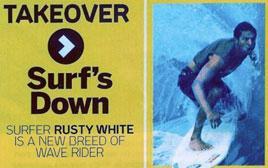Important Discussion About Engagement of More Varied Audiences for Appreciation of America’s Natural, Cultural and Historical Heritage
![]()
The folks who participated in the recent Sierra Club diversity conversation offered some useful observations as to how a better job can be done to engage audiences of color with historically low participation rates in connecting to America’s natural, cultural, and historical heritage.
If you missed the Sierra Club’s Mission Outdoors Google+ Hangout on Wednesday, February 27, 2013, you are in luck, as it can still be viewed on the web.

Competitive and traveling surfer Rusty White represented the Black surfing community in the Sierra Club’s Diversity conversation. (Article is from King magazine, August 2006.)
[View article]
The Sierra Club’s mission is to get people outside to local urban green spaces and watersheds, and distant, more remote landscapes to explore, enjoy, and protect America’s natural environment and cultural heritage. The ideas from the discussion most resonating with me were:
- Natural environment stewardship and historic preservation organizations should look for “outside-the-box” or “new” solutions to inspire and engage new audiences that are authentic and of mutual benefit, such as developing new partnerships with individuals and with new organizations and technologies that can disseminate their messages.
- The cultural and historical heritage of natural sites should be more developed to reach specific audiences and align with community values. For example, stories at National Parks in America’s Southwest — about the historically significant Hispanic heritage and Buffalo Soldiers — should be more fully developed and promoted so people of Latino descent and Black Americans have visits that can be more meaningful and relevant to their own experiences.
- In the education messages disseminated to the varied audiences about natural conservation and historic preservation, better connections to everyday life and community values need to be associated with quality-of-life issues for stewardship and for improvement of minds and bodies.
- To be successful in attracting new participants and leaders, natural environment stewardship and historic preservation organizations must make long-term commitments to developing sustained participation and engagement of new, more diverse audiences.
In my current work as a public historian, I reclaim local stories of African Americans beach culture heritage during the nation’s Jim Crow era (1910s–1960s) in Santa Monica and Manhattan Beach in Los Angeles County and other local sites. At the beach sites I am forging new partnerships with colleagues in ocean stewardship as well as in the history industry, social action and surfing, to build pathways to broader, younger and wider audiences to connect them with more culturally diverse stories of our shared, national heritage.
Both historic preservation and nature conservation address the common interests, values and goals of enjoying, protecting and preserving what is valuable to our community. Strategies may vary, but both movements focus on the fundamental need to keep all the unique and irreplaceable pieces of our heritage intact for all people to enjoy no matter what their background.
I urge you to listen to the Sierra Club Diversity dialog. I challenge you to use what you learn from it to invigorate your own work inspiring, engaging and empowering youth and their parents in your communities through meaningful education programs to help build personal experiences with natural, cultural and historical heritage. These individuals’ relations are the foundation of stewardship and the development of the next generation of enthusiastic participants and leaders in nature conservation and historic preservation.
Coming up soon, watch for my post of my more reflective thoughts on this subject.
Sierra Club President Allison Chin hosted the conversation with:
- Rue Mapp, founder and CEO of Outdoor Afro
- Audrey Peterman, author of Our True Nature: Finding a Zest for Life in the National Park System (2012) and Legacy on the Land: A Black Couple Discovers Our National Inheritance and Tells Why Every American Should Care (2009)
- Rusty White, a competitive and traveling surfer who was profiled in the film White Wash, a documentary about the history of black surfers in America
- Juan Martinez, the Director of Leadership Development and Natural Leaders Network for the Children and Nature Network
- Javier Sierra, a bilingual media strategist for the Sierra Club.
Listen to the whole discussion and view others’ comments about it at:
The Sierra Club
or
Huffington Post
http://www.youtube.com/watch?v=VB-OqHP44w8

